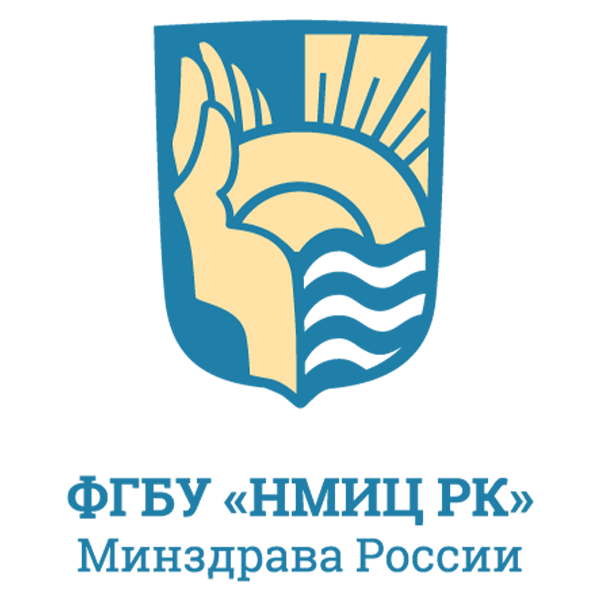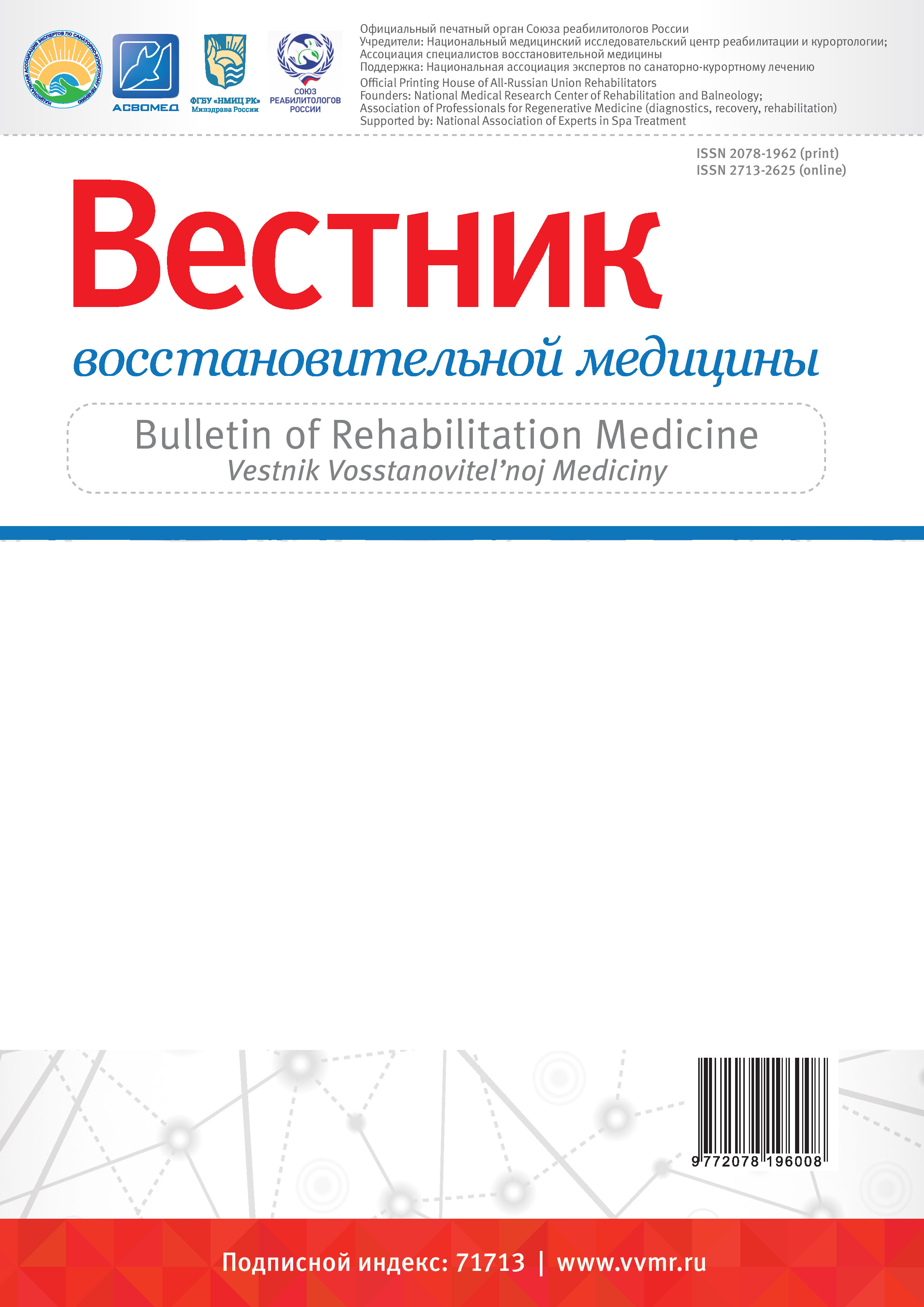The subject of this publication is the medical rehabilitation of children with perinatal lesions of the central nervous system. Currently, the main methodological principles of stage-by-stage medical rehabilitation of newborns, mainly children with the consequences of perinatal damage to the nervous system, have been determined. Special attention should be paid to the issue of minimal use of medicines in children with perinatal pathology, in this regard, an important task is the development and scientific justification of new non-drug technologies of medical rehabilitation, especially in children under 1 year. Medical rehabilitation sets itself the following tasks: stimulation of blood circulation in the brain tissues, improvement of muscle tone by affecting the central nervous system and the peripheral nervous system, activation of neuromuscular transmission processes and improvement of psychomotor development of a child with perinatal pathology of the central nervous system. Medical rehabilitation of children with perinatal lesions of the central nervous system begins at the earliest possible time and is carried out by specialists of a multidisciplinary rehabilitation team based on an individual medical rehabilitation program. Aim. To study the results of research conducted by Russian and foreign authors on the issues of physical rehabilitation of children with perinatal damage to the central nervous system and to conduct an analysis of the effectiveness of the proposed technologies. Material and methods. The literature review for this article was conducted from the elibrary, PubMed, Cochrane Library databases with a search depth of 10 years. The selection of publications was carried out using keywords: non-drug technologies, perinatal damage to the central nervous system; perinatal hypoxic-ischemic encephalopathy, kinesotherapy, neurodevelopmental therapy, massage, thin finger training method, dry immersion, fitball gymnastics, V. Voit therapy; Bobat therapy. Conclusion. Currently, a wide range of non-drug technologies of medical rehabilitation of children with the consequences of perinatal damage to the central nervous system is used such as therapeutic gymnastics, massage, kinesiotherapy with a neuroreflex locomotion according to Vojta's method, Bobath-therapy, massage, etc. The analysis of publications has shown that kinesotherapy and massage in in the complex of rehabilitation measures for children with perinatal lesions allows to increase the effectiveness of rehabilitation measures, reduce the severity of motor disorders, and can help reduce the frequency of formation of cerebral palsy.
nemedikamentoznye tehnologii, perinatal'noe porazhenie CNS, perinatal'naya gipoksicheski-ishemicheskaya encefalopatiya, kinezoterapiya, neyrorazvivayuschaya terapiya, massazh, metod tonkogo pal'cevogo treninga, suhaya immersiya, fitbol-gimnastika, terapiya po metodu V. Voyta, Bobat-terapiya, LFK
1. Federal'nye klinicheskie rekomendacii po okazaniyu medicinskoy pomoschi detyam s posledstviyami perinatal'nogo porazheniya central'noy nervnoy sistemy. Soyuz pediatrov Rossii. 2016: 11 s.
2. Abdiganieva S.A., Karimov F.M., Hamidov G.S. Perinatal'nye porazheniya central'noy nervnoy sistemy. Avicenna. 2019; (31): 8-9.
3. Hagberg H., David Edwards A., Groenendaal F. Perinatal brain damage: The term infant. Neurobiology. 2016; 92(A): 102-12. https://doi.org/10.1016j.nbd.2015.09.011
4. Zdravoohranenie v Rossii 2019 Statisticheskiy sbornik. Federal'naya sluzhba gosudarstvennoy statistiki (Rosstat). Moskva. 2019: 170 s.
5. Han M.A., Kuyanceva L.V., Novikova E.V. Nemedikamentoznye tehnologii medicinskoy reabilitacii detey s perinatal'noy patologiey. Vestnik vosstanovitel'noy mediciny. 2015; (6): 22 c.
6. Karkashadze G.A., Anikin A.V., Zimina E.P. Sovremennye dannye o patogeneze i lechenii gipoksicheski-ishemicheskih porazheniy golovnogo mozga u novorozhdennyh. Pediatricheskaya farmakologiya. 2016; T.13(5): 452-467. https://doi.org/10.15690/pf.v13i5.1641
7. Dement'eva G.M., Ryumina I.I., Frolova M.I. Vyhazhivanie glubokonedonoshennyh detey: sovremennoe sostoyanie problemy. Pediatriya. 2004; (3): 60-66.
8. Chang H.H., Larson J., Blencowe H., Spong C.Y., Howson C.P., Cairns-Smith S., Lackritz E.M., Lee S.K., Mason E., Serazin A.C., Walani S., Simpson J.L., Lawn J.E. Born Too Soon preterm prevention analysis group. Preventing preterm births: analysis of trends and potential reductions with interventions in 39 countries with very high human development index. Lancet. 2013; 381(9862): 223-34. https://doi.org/10.1016 S0140-6736(12)61856-X
9. Saharova E.S., Keshishyan E.S., Alyamovskaya G.A. Osobennosti psihomotornogo razvitiya glubokonedonoshennyh detey. Vestnik sovremennoy klinicheskoy mediciny. 2013; 6(6): 84-90.
10. Shabalov N.P., Neonatologiya. Uchebnoe posobie. MEDpress-inform. 2014: 22 s.
11. Novak C.M., Ozen M., Burd I. Perinatal Brain Injury: Mechanisms, Prevention and Outcomes. Clinics in Perinatology. 2018; 45(2): 357-375. https://doi.org/10.1016j.clp.2018.01.015
12. Karkashidze G.A., Anikin A.V., Zimina E.P., Davydova I.V., Karimova H.M., Zaharyan M.E., Namazova-Baranova L.S., Maslova O.I., Yacyk G.V., Valieva S.I., Gevorkyan A.K. Sovremennye dannye o patogeneze i lechenii gipokischeski-ishemicheskih porazheniy golovnogo mozga u novorozhdennyh. Pediatricheskaya farmakologiya. 2016; T.13(5): 452-467.
13. Badalyan L.O., Zhurba L.T., Vsevolozhskaya N.M. Rukovodstvo po nevrologii rannego vozrasta. Kiev. Zdorov'e. 1980: 120 s.
14. Zavadenko N.N. Disfaziya razvitiya u detey: perspektivy neyrotroficheskoy terapii. Zhurnal nevrologii i psihiatrii im. S.S. Korsakova. 2013; 5(2): 43-47.
15. Suslova G.A., Bure N.P. Kompleksnaya medicinskaya reabilitaciya novorozhdennyh i nedonoshennyh detey v usloviyah perinatal'nogo, konsul'tativno-diagnosticheskogo i mnogoprofil'nogo centrov. Materialy kongressa «Zdorovye deti - buduschee strany». 2017; (8): 312-313.
16. Nalobina A.N., Karaseva I.A. Tehnologiya primeneniya sredstv adaptivnoy fizicheskoy kul'tury v reabilitacii nevrologicheskih bol'nyh. Izvestiya Tul'skogo gosudarstvennogo universiteta. Fizicheskaya kul'tura. Sport. 2020; (6): 60-68. https://doi.org/10.24411/2305-8404-2020-10608
17. Kalinina I.N., Tihonov S.V., Polustruev A.V. Dinamika teplovizornyh priznakov perinatal'nogo porazheniya central'noy nervnoy sistemy pod vliyaniem ruchnogo massazha u detey pervogo goda zhizni. Sovremennye problemy nauki i obrazovaniya. 2011; (5): 127-131.
18. Kozhevnikova T.V. Sovremennye tehnologii fizicheskoy reabilitacii bol'nyh s posledstviyami perinatal'nogo porazheniya nervnoy sistemy i detskim cerebral'nym paralichom. Moskva. 2013: 566 s.
19. Rasool F., Memon A.R., Kiyani M.M., Sajjad A.G. The effect of deep cross friction massage on spasticity of children with cerebral palsy: A double-blind randomised controlled trial. Journal of Pakistan Medical Association. 2017; 67(1): 87-91.
20. Field T., Diego M., Hernandez-Reif M. Preterm infant massage therapy research: a review. Infant Behavior and Development. 2010; 33(2): 115-24. https://doi.org/10.1016/j.infbeh.2009.12.004
21. Leavy A., Jimenez Mateos E.M. Perinatal Brain Injury and Inflammation. Lessons from Experimental Murine Models. Cells. 2020; 9(12): 2640 p. https://doi.org/10.3390/cells9122640
22. Volyanyuk E.V. Rezul'taty monitoringa zabolevaemosti i ishodov razvitiya k 3 godam zhizni u nedonoshennyh detey, rodivshihsya s ekstremal'no nizkoy massoy tela. Prakticheskaya medicina. 2019; T.17(5): 175-179.
23. Dolotova N.V., Fil'kina O.M., Il'in A.G., Malyshkina A.I. Fizicheskoe razvitie detey-invalidov vsledstvie zabolevaniy nervnoy sistemy. Mat' i ditya v Kuzbasse. 2014; 3(58): 35-38.
24. Ivanov V.A. Vazhneyshie aspekty izucheniya patologii CNS u detey. Kursk. Kurskiy gosudarstvennyy universitet. 2014: 26 s.
25. Kiosov A.F. Problemy opredeleniya ponyatiya zaderzhki vnutriutrobnogo rosta i diagnostiki etoy patologii. Doktor.Ru. 2020; 19(3): 6-11. https://doi.org/10.31550/1727-2378-2020-19-3-6-11
26. Panchenko A.S., Panova M.S. Biohimicheskie markery gipoksicheskogo porazheniya golovnogo mozga u donoshennyh novorozhdennyh. Doktor.Ru. 2020; 19(3): 12-16. https://doi.org/10.31550/1727-2378-2020-19-3-12-16
27. Álvarez M.J., Fernández D., Gómez-Salgado J., Rodríguez-González D., Rosón M., Lapeña S. The effects of massage therapy in hospitalized preterm neonates: A systematic review. International Journal of Nursing Studies. 2017; (69): 119-136. https://doi.org/10.1016/j.ijnurstu.2017.02.009
28. Krasikova I.S. Detskiy massazh. massazh i gimnastika dlya detey ot rozhdeniya do treh let. 2020: 320 c.
29. Lee Y.B., Chow R.S.Y., Pang C.B. Impact of massage therapy on motor outcomes in very low-birthweight infants: randomized controlled pilot study. International Journal of Nursing Studies. 2010; 52(3): 378-385. https://doi.org/10.1111/j.1442-200X.2009.02964
30. Nalobina A.N., Patyukov A.G. Vliyanie fitbol-gimnastiki na psihomotornoe razvitie i vegetativnye funkcii detey pervogo goda zhizni s perinatal'nym porazheniem central'noy nervnoy sistemy. Omskiy nauchnyy vestnik. 2012; 1(106): 187-191 c.
31. Potapchuk A.A., Kazanskaya E.V. Fizicheskaya reabilitaciya detey pervogo goda zhizni s perinatal'nymi povrezhdeniyami central'noy nervnoy sistemy. Uchenye zapiski SPbGMU im. akad. I.P. Pavlova. 2016; T.23(3).
32. Polyakov O.A., Laysheva O.A., Il'ina E.S. Dinamika klinicheskih proyavleniy narusheniya dvigatel'nyh funkciy u detey s sindromom opsoklonus-mioklonus pri primenenii razlichnyh reabilitacionnyh metodik. Detskaya i podrostkovaya reabilitaciya. 2017; 2(30): 18-23.
33. Shenkman B.S. Suhaya immersiya kak ideal'naya model' dlya issledovaniy gravitacionnogo kontrolya postural'noy myshcy cheloveka. Zhurnal evolyucionnoy biohimii i fiziologii. 2020; T.56(7): 835 c. https://doi.org/10.31857/S0044452920072577
34. Bure N.P., Bochkarev I.A., Suslova G.A., Olina O.S., Smirnova T.V. Ispol'zovanie metoda "suhoy immersii" dlya nedonoshennyh detey i detey grudnogo vozrasta na stacionarnom etape medicinskoy reabilitacii. Detskaya medicina Severo-Zapada. 2018; T.7(1): 50-51.
35. Smith S.L., Haley S., Slater H., Moyer-Mileur L.J. Heart rate variability during care giving and sleep after massage therapy in preterm infants. Early Human Development. 2013; 89(8): 525-9. https://doi.org/10.1016/j.earlhumdev.2013.01.004
36. Basharova A.P. Primenenie metoda Bobat-terapii v individual'noy psihologo-pedagogicheskoy rabote s det'mi s tyazhelymi formami DCP. Materialy Zabaykal'skogo gosudarstvennogo universiteta. 2017: 227-230.
37. Tekin F., Kavlak E., Cavlak U., Altug F. Effectiveness of Neuro-Developmental Treatment (Bobath Concept) on postural control and balance in Cerebral Palsied children. Pamukkale University, School of Physical Therapy and Rehabilitation. 2018; 31(2): 397-403.
38. Purgina N.M., Sabir'yanova E.S. Effektivnost' Bobat-terapii v kompleksnoy reabilitacii pacientov, perenesshih ishemicheskiy insul't. Fizicheskaya kul'tura i sport: nauka, obrazovanie, tehnologii. Chelyabinsk. Ural'skiy gosudarstvennyy universitet fizicheskoy kul'tury. 2019: 346-349.
39. Belyaeva I.A., Bombardirova E.P., Tokovaya E.I. Nemedikamentoznaya abilitaciya detey s perinatal'nymi porazheniyami nervnoy sistemy. Voprosy sovremennoy pediatrii. 2017; T.16(5): 383-391. https://doi.org/10.15690/vsp.v16i5.1802
40. Sanz-Esteban I., Calvo-Lobo C., Ríos-Lago M., Álvarez-Linera J., Muñoz-García D., Rodríguez-Sanz D. Mapping the human brain during a specific Vojta's tactile input: the ipsilateral putamen's role. Medicine (Baltimore). 2018; 97(13): e0253 p. https://doi.org/10.1097/MD.0000000000010253
41. Askevova M.A., Shanavazova M.D. Voyta-terapiya v abilitacii nedonoshennyh detey. Nevrologiya: vzglyad molodyh. Mahachkala. 2020: 24-30.
42. Jung M.W., Landenberger M., Jung T., Lindenthal T., Philippi H. Vojta therapy and neurodevelopmental treatment in children with infantile postural asymmetry: a randomised controlled trial. The Journal of Physical Therapy Science. 2017; 29(2): 301-306. https://doi.org/10.1589/jpts.29.301
43. Chris Gale, Yevgeniy Statnikov, Sena Jawad, Sabita N Uthaya, Neena Modi. Neonatal brain injuries in England: population-based incidence derived from routinely recorded clinical data held in the National Neonatal Research Database. Archives of Disease in Childhood. Fetal and Neonatal Edition. 2018; 103(4): F301-F306. https://doi.org/10.1136/archdischild-2017-313707
44. Pankrat'eva L.L., Volodin N.N. Metodologicheskie problemy reabilitacii nedonoshennyh detey. Zhurnal im. G.N. Speranskogo. 2019; T.98(2): 14-18. https://doi.org/10.24110/0031-403X-2019-98-2-14-18
45. Statnikov Y., Ibrahim B., Modi N. A systematic review of administrative and clinical databases of infants admitted to neonatal units. Archives of Disease in Childhood. Fetal and Neonatal Edition. 2017; 102(3): F270-F276. https://doi.org/10.1136/archdischild-2016-312010
46. Dolotova N.V., Fil'kina O.M., Vorob'eva E.A., Kuz'menko G.N. Sostoyanie zdorov'ya i otdel'nye mehanizmy formirovaniya ego narusheniy u detey-invalidov v rezul'tate posledstviy perinatal'nyh porazheniy central'noy nervnoy sistemy v vozraste do 4 let. Lechenie i profilaktika. 2018; T.8(1(25)): 13-18.





